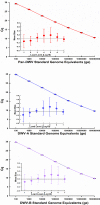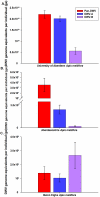A real-time PCR method for quantification of the total and major variant strains of the deformed wing virus
- PMID: 29261772
- PMCID: PMC5736226
- DOI: 10.1371/journal.pone.0190017
A real-time PCR method for quantification of the total and major variant strains of the deformed wing virus
Abstract
European honey bees (Apis mellifera) are critically important to global food production by virtue of their pollination services but are severely threatened by deformed wing virus (DWV) especially in the presence of the external parasite Varroa destructor. DWV exists as many viral strains with the two major variants (DWV-A and DWV-B) varying in virulence. A single plasmid standard was constructed containing three sections for the specific determination of DWV-A (VP2 capsid region), DWV-B (IRES) and a conserved region suitable for total DWV (helicase region). The assays were confirmed as specific and discriminatory with limits of detections of 25, 25 and 50 genome equivalents for DWV-A, DWV-B and total-DWV, respectively. The methods were successfully tested on Apis mellifera and V. destructor samples with varying DWV profiles. The new method determined a more accurate total DWV titre in samples with substantial DWV-B than the method currently described in the COLOSS Beebook. The proposed assays could be utilized for the screening of large quantities of bee material for both a total DWV load overview along with more detailed investigations into DWV-A and DWV-B profiles.
Conflict of interest statement
Figures







Similar articles
-
Deformed Wing Virus Infection in Honey Bees (Apis mellifera L.).Vet Pathol. 2019 Jul;56(4):636-641. doi: 10.1177/0300985819834617. Epub 2019 Mar 11. Vet Pathol. 2019. PMID: 30857499
-
The Two Prevalent Genotypes of an Emerging Infectious Disease, Deformed Wing Virus, Cause Equally Low Pupal Mortality and Equally High Wing Deformities in Host Honey Bees.Viruses. 2019 Jan 29;11(2):114. doi: 10.3390/v11020114. Viruses. 2019. PMID: 30699904 Free PMC article.
-
Genetic Diversity of Deformed Wing Virus From Apis mellifera carnica (Hymenoptera: Apidae) and Varroa Mite (Mesostigmata: Varroidae).J Econ Entomol. 2019 Feb 12;112(1):11-19. doi: 10.1093/jee/toy312. J Econ Entomol. 2019. PMID: 30285237
-
Deformed Wing Virus in Honeybees and Other Insects.Annu Rev Virol. 2019 Sep 29;6(1):49-69. doi: 10.1146/annurev-virology-092818-015700. Epub 2019 Jun 11. Annu Rev Virol. 2019. PMID: 31185188 Review.
-
Impact of managed honey bee viruses on wild bees.Curr Opin Virol. 2016 Aug;19:16-22. doi: 10.1016/j.coviro.2016.06.006. Epub 2016 Jun 25. Curr Opin Virol. 2016. PMID: 27351468 Review.
Cited by
-
Virus Prevalence in Egg Samples Collected from Naturally Selected and Traditionally Managed Honey Bee Colonies across Europe.Viruses. 2022 Nov 3;14(11):2442. doi: 10.3390/v14112442. Viruses. 2022. PMID: 36366540 Free PMC article.
-
Establishment and Application of CRISPR-Cas12a-Based Recombinase Polymerase Amplification and a Lateral Flow Dipstick and Fluorescence for the Detection and Distinction of Deformed Wing Virus Types A and B.Viruses. 2023 Oct 1;15(10):2041. doi: 10.3390/v15102041. Viruses. 2023. PMID: 37896818 Free PMC article.
-
Interaction between the VP2 protein of deformed wing virus and host snapin protein and its effect on viral replication.Front Microbiol. 2023 Feb 8;14:1096306. doi: 10.3389/fmicb.2023.1096306. eCollection 2023. Front Microbiol. 2023. PMID: 36846748 Free PMC article.
-
Can the examination of different types of hive samples be a non-invasive method for detection and quantification of viruses in honey bee (Apis mellifera L.) colonies?J Vet Res. 2023 Sep 20;67(3):323-331. doi: 10.2478/jvetres-2023-0046. eCollection 2023 Sep. J Vet Res. 2023. PMID: 37786848 Free PMC article.
-
Codon optimization, expression in Escherichia coli, and immunogenicity analysis of deformed wing virus (DWV) structural protein.PeerJ. 2020 Mar 11;8:e8750. doi: 10.7717/peerj.8750. eCollection 2020. PeerJ. 2020. PMID: 32201647 Free PMC article.
References
-
- Leonhardt SD, Gallai N, Garibaldi LA, Kuhlmann M, Klein A. Economic gain, stability of pollination and bee diversity decrease from southern to northern Europe. Basic Appl Ecol 2013;14(6):461–471.
-
- Watanabe ME. Pollination worries rise as honey bees decline. Science 1994;265(5176):1170 doi: 10.1126/science.265.5176.1170 - DOI - PubMed
-
- Gallai N, Salles J, Settele J, Vaissière BE. Economic valuation of the vulnerability of world agriculture confronted with pollinator decline. Ecol Econ 2009;68(3):810–821.
-
- Lee KV, Steinhauer N, Rennich K, Wilson ME, Tarpy DR, Caron DM, et al. A national survey of managed honey bee 2013–2014 annual colony losses in the USA. Apidologie 2015;46(3):292–305.
-
- Potts SG, Roberts SPM, Dean R, Marris G, Brown MA, Jones R, et al. Declines of managed honey bees and beekeepers in Europe. J Apic Res 2010;49(1):15–22.
MeSH terms
Supplementary concepts
LinkOut - more resources
Full Text Sources
Other Literature Sources

